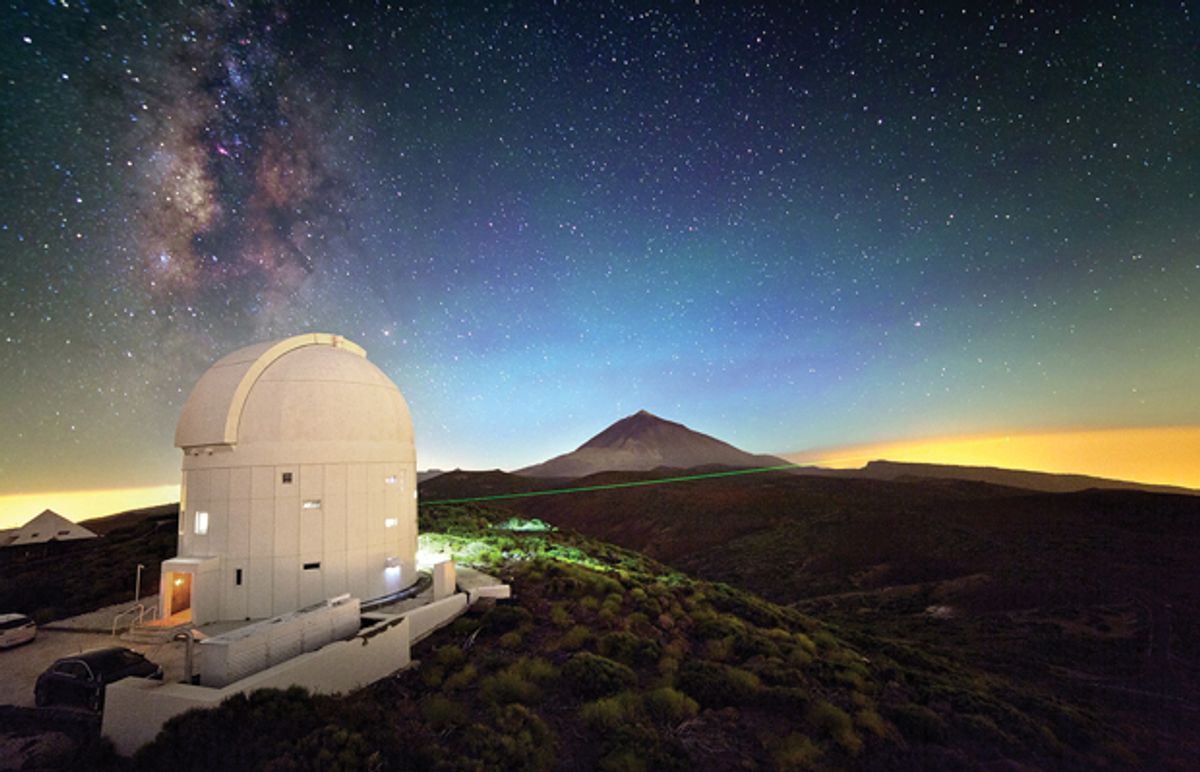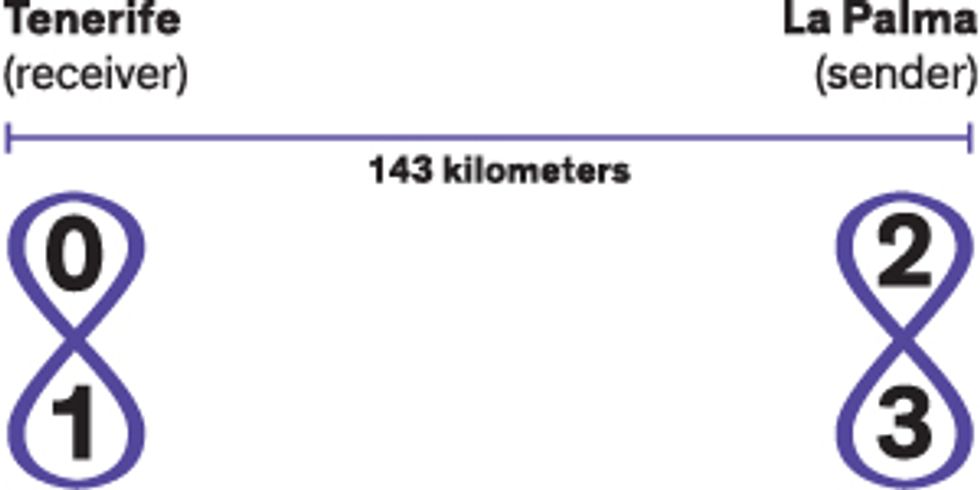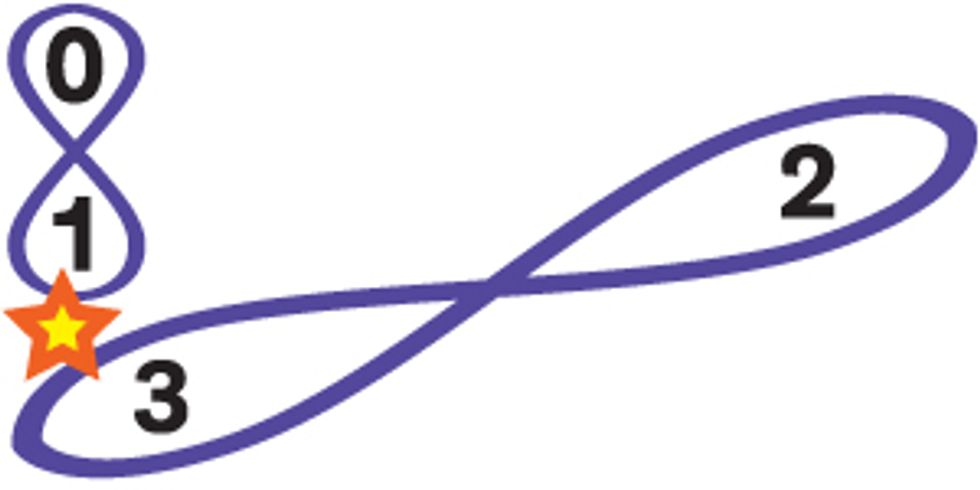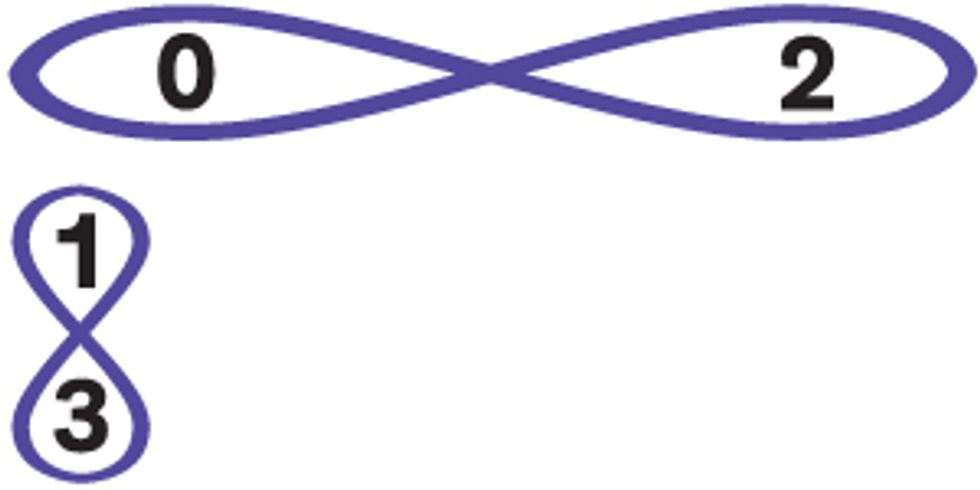In theory, the counterintuitive workings of quantum mechanics can guarantee that digital communications are utterly immune to prying eyes. That theory has advanced quickly, but the practice is now catching up, thanks to two developments by one of the field’s pioneers.
University of Vienna physicist Anton Zeilinger and his team realized the first teleportation of photons in 1997. Not to be confused with the stock-in-trade of Star Trek’s Montgomery Scott, teleportation is the instantaneous transfer of the properties of one particle to another distant one; it’s key to perhaps the most unassailable version of quantum communications. In November, Zeilinger and his team reported that they’d taken the process two important steps further.
First, they teleported not just a photon’s usual properties but also its strangest one: entanglement. What’s more, they did it over a record distance of 143 kilometers, linking the Canary Islands of La Palma and Tenerife. That distance is particularly significant, because it’s nearly as far as the boundary of low Earth orbit.
Second, they pulled off a similar feat—although over a much shorter distance—using twisted light, the kind featuring photons having a property called orbital angular momentum. Photonics experts hope orbital angular momentum could hugely increase the bandwidth of optical telecommunications networks.
Entanglement Swapping
Two pairs of photons, one pair (0,1) at a receiver on Tenerife and the other (2,3) at a transmitter on La Palma, in the Canary Islands, are entangled with each other.
Photon 3 is sent to Tenerife, and a measurement is made on it and photon 1 simultaneously.
Photon 1 and 3 are now entangled, and so are photons 0 and 2—despite the fact that they never came near each other.
Entanglement is a quantum phenomenon. When a pair of particles, such as photons, are created in a single physical process or interact with each other in a particular way, they become entangled—that is, they start behaving like a single particle, even when they become separated by any distance.
Teleportation of entanglement, also known as entanglement swapping, makes use of another curious phenomenon: It’s also possible to entangle two photons by performing a joint measurement on them, known as a Bell-state measurement. Once these photons are linked, switching the polarization of one of them—say, from up to down—causes an instantaneous switch of the other photon’s polarization, from down to up.
Here’s how the entanglement swap works: Assume you have two pairs of entangled photons, 0 and 1 in the receiving station and 2 and 3 in the transmitting station. Both entangled pairs are completely unaware of each other; in other words, no physical link exists between them. Now, assume you send photon 3 from the transmitter to the receiver and perform a Bell-state measurement simultaneously on photon 3 and on photon 1. As a result, 3 and 1 become entangled. But surprisingly, photon 2, which stayed home, is now entangled with photon 0, at the receiver. The entanglement between the two pairs has been swapped, and a quantum communication channel has been established between photons 0 and 2, although they’ve never been formally introduced [see illustration, "Entanglement Swapping"].
Entanglement swapping will be an important component of future secure quantum links with satellites, says Thomas Scheidl, a member of Zeilinger’s research group.
The team is working with a group at the University of Science and Technology of China on a satellite project led by Zeilinger’s former Ph.D. student Jian Wei Pan. Next year, when the Chinese Academy of Sciences launches its Quantum Science Satellite—which will have an onboard source of entangled photons—the satellite and ground stations in Europe and China will form the first space–Earth quantum network. They will implement a quantum-key relay protocol, securely linking the ground stations in Europe and China, says Scheidl.
The Quantum Science Satellite will be launched into a low Earth orbit and will communicate with one ground station at a time. “The satellite flies over a ground station in Europe and establishes a quantum link to the ground station, and you generate a key between the satellite and the ground station in Europe. Then, some hours later, the satellite will pass a ground station in China and establish a second quantum link and secure key with a ground station in China,” Scheidl explains.
“The satellite then has both keys available, and you can combine both keys into one key,” he adds. “Then you send, via a classical channel, the key combination to both of the ground stations. This you can do publicly because no one can learn anything from this combined key. Because one ground station has an individual key, it can undo this combined key and learn about the key of the other ground station.”
The future quantum Internet will need a network of satellites and ground stations, similar to that of the Global Positioning System, in order to exchange quantum keys instantaneously.
Kilometer distances for transmitting twisted light—light having an orbital angular momentum, or a wave front that resembles fusilli pasta—were proved possible a year ago by the Vienna team. “Last year was a necessary step, and it was successful,” says Mario Krenn, a member of Zeilinger’s research group. They knew that entangling twisted photons was the next step that could increase the bandwidth of quantum-key generation. And that’s just what Krenn and his colleagues have done, entangling twisted photons and sending them 3 kilometers from each other: “We were able to show that on the single photon level, each photon can keep information in the form of orbital angular momentum over a large distance and can be entangled even after 3 kilometers.”
The control of twisted quantum states is much more complicated than the control of polarization states, but the possibility of being able to entangle photons on multiple levels is worth the effort, says Krenn. Photons can exist only in two polarization states or levels, up and down. But the number of orbital angular momentum states is, in theory, unlimited, explains Krenn. “In the lab, we have shown that we can create a 100-dimensional entanglement—up to a hundred different levels of the photons can be entangled.” And that will mean a truly high-bandwidth, uncrackable global network.

 Two pairs of photons, one pair (0,1) at a receiver on Tenerife and the other (2,3) at a transmitter on La Palma, in the Canary Islands, are entangled with each other.
Two pairs of photons, one pair (0,1) at a receiver on Tenerife and the other (2,3) at a transmitter on La Palma, in the Canary Islands, are entangled with each other. Photon 3 is sent to Tenerife, and a measurement is made on it and photon 1 simultaneously.
Photon 3 is sent to Tenerife, and a measurement is made on it and photon 1 simultaneously. Photon 1 and 3 are now entangled, and so are photons 0 and 2—despite the fact that they never came near each other.
Photon 1 and 3 are now entangled, and so are photons 0 and 2—despite the fact that they never came near each other.